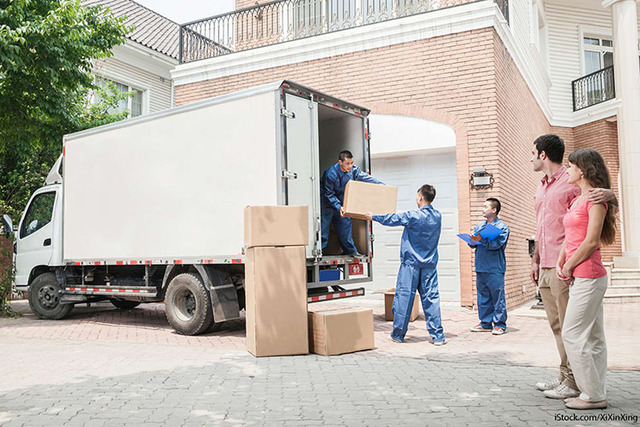9 best-kept moving secrets only insiders know
It’s a common saying that moving is the third most stressful event in a person’s life, behind death and divorce. Actually, the Holmes and Rahe Stress Scale that measures the stress of major life events lists it at No. 32, but it certainly speaks to people’s collective loathing of the moving experience. It’s expensive, time-consuming and tiring. There’s pretty much no way around it: Moving is a drag.
The average cost to move depends widely on where you live, where you’re moving, how far away those two places are and how much stuff you have. How quickly you want to do it and even when you need to move can impact the cost. The average moving cost runs from about $840 to $4,460 for your average one-bedroom apartment, according to an analysis by Unpakt, a site that generates moving quotes. That’s just for the actual move, not including all those incidentals, like boxes and packing material, overnight stays in hotels, cleaning, storage and the nebulous cost of things going wrong.
But a few moving secrets from the pros can help you save money on moving — not to mention time and stress. In the midst of a big move, sometimes that can feel like the bigger victory.
Let’s start with a simple one: Don’t buy boxes. Instead, get them from local grocery and retail stores, ApartmentTherapy.com recommended. You have to call ahead to figure out the best day and time to pick them up, and you’ll probably have to make a few trips, but most places are happy to give away their boxes for free. Now, you’re already on your way to a cheaper move.
1. Finish Packing Before the Move — Seriously
Admittedly, this tip doesn’t take deep insider knowledge to figure out, but it’s the No. 1 tip movers emphasize. “Unexpected packing will immediately increase the duration of your move and your estimate costs,” said Joe Devost, move operations field manager at moving company You Move Me.
Turning a four-hour move into an all-day affair can mean you need to keep your movers or your truck longer, and a longer move out can delay moving in. You might even find yourself unable to unload the truck in the same day, triggering more costs and headaches.
The trouble is that many people think they’re totally packed when they’re not. They’re rushing around stuffing boxes full of last-minute items, drawers that weren’t emptied, corners of the basement that were left forgotten. It takes about six weeks to fully pack for a move, said Melissa Sullivan, communications director for moving company Mayflower. So devise and implement a six-week plan that will keep you from avoiding that dreaded last-minute rush.
Devost recommended this order: “Begin packing with your storage areas, anything you haven’t used for a year and cannot guarantee you will need again, and items that have no sentimental value, should be the first to go. Move on to the rooms you will use infrequently prior to moving. The last items you pack up prior to your move will be your everyday kitchen, bedroom and bathroom belongings.”
2. Create a Moving Day Bug-Out Bag
A bug-out bag is a survival kit containing all the items you would need to survive for around 72 hours in the event you must evacuate a disaster area. Moving doesn’t qualify as a disaster, but it can feel like one, so creating a similar bag full of all the items you will need to survive the move can be a real lifesaver.
Keeping the essentials on hand can also potentially save you time and money, so you don’t have to go in search of, or buy replacements for, those items when you need them. Here’s a list of items to include:
- One extra outfit
- Toothbrush and toothpaste
- Hairbrush and other accessories you need that day
- First-aid kit and necessary medications
- Cellphone and charger
- Any moving information you need — addresses, truck or mover details
- Wallet
- Keys
- A little food to tide you over
3. Have a Moving Truck Loading Plan
It’s important to load the truck properly to avoid damaging your belongings — as well as the expense that can come with repairing or replacing damaged items. Load your items into the truck in the following order: Heavy furnishings such as dressers, desks and trunks, first. These items will serve as the base and foundation of your truck load, Devost said. Then boxes, followed by lighter items such as chairs, luggage, rugs, etc.
If you’re doing it yourself, loading this way will best protect your items. If you’re hiring movers, consider arranging your boxes in one area out of the way so the heavy items can be moved easily first.
4. Get a Shoulder Dolly
If you’ve ever hired truly professional movers, you’ve probably noticed this nifty little device many have called a Shoulder Dolly, or a two-person moving strap system. It’s a device that has a sturdy strap connecting two backpack-like shoulder straps. You secure it underneath a heavy item — think washers and dryers, heavy dressers, couches — then you and a partner put on the straps, grab the item and lift.
The redistribution of weight makes the items easier to lift and carry, and it leaves your hands free to stabilize the item as you navigate tight or awkward spaces and open doors along the way. Having more control when moving heavy items can help you avoid dropping and damaging them, and any costs associated with repairing or replacing them.
5. Use Blankets to Protect Sensitive Furniture
One of the unexpected costs of moving can come from damaged furniture that needs to be replaced or repaired. If you’re not hiring movers or don’t want to invest in moving blankets, you can always wrap particularly sensitive furniture in your own blankets and secure with tape. Although a moving blanket has extra padding that a regular blanket might not, and you risk possibly damaging or dirtying your blanket, it’s a legitimate and less expensive option when the last thing you want is to scratch or ding a pricey piece of furniture.
6. Request a Binding Estimate When Hiring Movers
You might have a tough time estimating how long a move will take, so asking for a visual survey to seal the cost of the move can help you budget better.
“We recommend requesting a binding estimate or quote that will cap the cost of your move,” Devost said. “This should come with a mandatory visual survey, as well as other company requirements.”
Otherwise, you should be prepared for the possibility of the move taking longer than expected, and the extra costs you might incur. Make sure you ask the movers how additional hours are billed.
7. Reserve a Spot for Your Moving Truck
If at all possible, reserve a good spot for your moving truck when necessary. Many municipalities offer moving residents the opportunity to ban parking for a portion of the street for a set number of hours. Having easy access to the truck that cuts down on a minute or two of heavy lifting each trip can make a huge difference in both the time and effort that goes into your move. Keeping your move as efficient as possible can help you avoid going into overtime, along with any costs associated with that.
8. Avoid Peak Moving Times
You might have no choice but to move on the last day of the month. Most people don’t, which is why so many people move that day, clogging the schedules of movers and truck rental companies. However, avoiding the last day of the month, as well as peak times from May to mid-September, can save you money, Sullivan said.
9. Check in With the IRS
One of the best-kept moving secrets is to notify the IRS that you’ve moved. Every year, the post office is unable to deliver thousands of refund checks because people don’t inform the IRS of their new residence, Sullivan said. The United States Postal Service mail forwarding service only forwards mail for a set amount of time, and certain types of mail stop getting forwarded after 60 days. So if tax day falls outside of your forwarding period, you might miss out on that check.
You should also check out the IRS website for more information on whether you can write off your move. Generally speaking, if you moved more than 50 miles away for a full-time job, you might be able to deduct moving expenses from your taxes.
From GoBankingRates.com: 9 best-kept secrets only insiders know
RELATED
How to save for a new home while renting
Why your 40s are a good time to downsize your home





























